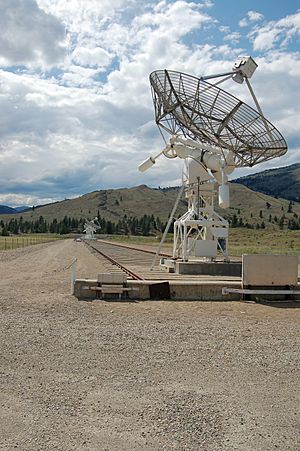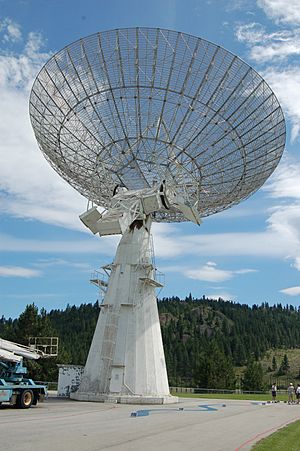Dominion Radio Astrophysical Observatory facts for kids
| Location | 717 White Lake Road Kaleden, British Columbia, Canada V0H 1K0 |
|---|
The Dominion Radio Astrophysical Observatory (DRAO) is a special place in Kaleden, British Columbia, Canada. It was started in 1960. This observatory is a research facility. Scientists here use giant radio telescopes to study space.
The DRAO has four main radio telescopes. These include a special interferometric radio telescope. There is also a large 26-meter single dish antenna. A solar flux monitor helps study the Sun. The newest addition is the Canadian Hydrogen Intensity Mapping Experiment (CHIME). The observatory also has engineering labs. Here, they design and build new equipment. The Herzberg Institute of Astrophysics runs the DRAO. This is part of the Government of Canada. The DRAO is famous for being the first to use Very Long Baseline Interferometry (VLBI). This is a way to combine signals from many telescopes.
Contents
Cool Tools for Space Study
The Synthesis Telescope
The Synthesis Telescope is made of seven large antennas. Each antenna is nine meters wide. They are spread out along a 600-meter line. This line goes from east to west. These antennas are like big metal-mesh dishes.
They have special receivers that pick up radio waves. These waves come from space at different frequencies. One frequency is 408 MHz. Another is 1420 MHz. Scientists use these signals to create detailed maps of the sky. This mapping method is called aperture synthesis. It combines signals from all antennas. This makes them act like one giant telescope.
The John A. Galt Telescope
The John A. Galt Telescope is a single large dish. It is about 25.6 meters (84 feet) wide. This telescope can listen to many different radio frequencies. These include the hydrogen line near 1.4 GHz. It also listens to other special signals. These signals come from molecules like OH and methanol in space.
This telescope used to be called the 26-meter Telescope. In 2014, it was renamed. This was to honor John A. Galt. He was the first employee and a former director of the DRAO. The Galt telescope was very important. It helped with the first successful measurements using very long baseline interferometry. This technique links telescopes far apart.
The Solar-Flux Monitor
The solar-flux monitor helps scientists study the Sun. It has two solid dish antennas. These dishes are located near Penticton, British Columbia. They both observe the Sun at the same time. They specifically look at radio waves with a 10.7-centimeter wavelength. This helps scientists understand the Sun's activity.
The Canadian Hydrogen Intensity Mapping Experiment (CHIME)
The Canadian Hydrogen Intensity Mapping Experiment (CHIME) is a unique radio telescope. It is designed to map the 21 cm line from neutral hydrogen. This helps scientists study the early universe. It looks at hydrogen from when the universe was much younger.
CHIME is made of four large cylindrical antennas. Each cylinder is 100 meters long and 20 meters wide. Along each cylinder, there are 256 special antennas. These antennas pick up radio waves. The data from CHIME helps measure something called baryon acoustic oscillations. This helps scientists figure out how fast the universe has been expanding.
Engineering and Innovation
The DRAO is not just for observing space. It also has labs where engineers work. They design and build new equipment. This includes receivers and other electronics. Their work helps improve the telescopes at DRAO. They also create instruments for other big observatories. Examples include the Very Large Array and the James Clerk Maxwell Telescope. This shows how important their engineering skills are for astronomy around the world.




